-
One Ocean for Potential TS Nine
Posted on July 28th, 2020 No commentsIn terms of the ocean, we have never been more ready. Potential Tropical Storm Nine is crossing over the same ocean in all the forecast models.
Here is SST from HMON’s HYCOM. This is part of the global GOFS to global RTOFS to regional HYCOM value chain.
We see the same features we talked about in the morning blog on the global models.
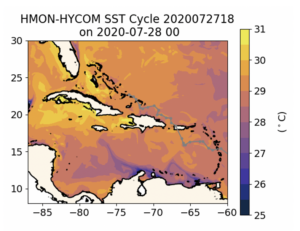
Here is the SST from HWRF that is coupled to MPIPOM. Focus on the Caribbean and along the track of the storm. The features are nearly the same. The cold water upwelled along the coast of South America is being advected around the Caribbean-wide anticyclonic feature south of Hispaniola in HMON and HWRF. The warmest water is up by Puerto Rico where AOML has the densest part of glider picket line in place well in advance. We saw in the morning blog that within that region covered by the gliders, the global models are all in really good agreement, telling us that even the different assimilation schemes appear to be bringing us closer together. The temperature ranges are so similar in these plots. All the US models are lining up in agreement on the basic Essential Ocean Features and temperature range before the storm, with the European Copernicus now representing a similarly structured but slightly warmer version of the ocean.
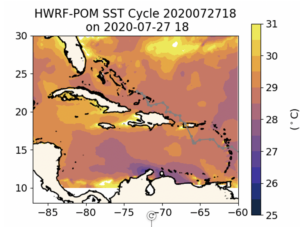
Much more to look at tonight. But from this initial look at the ocean side, we can’t be more ready.
-
Preparing for Potential TC Nine
Posted on July 28th, 2020 No commentsNHC 11 am message renamed the disturbance Potential Tropical Cyclone Nine. Prompts us to do a quick tour of the data assimilative global models, Navy GOFS and European Copernicus.
First is GOFS SST, and below it Copernicus SST. Maria has made these new plots easier to interpret. Colors are now in 0.5C increments, with the range tuned to each region. First impression is that Copernicus warmer than GOFS, often by about 0.5 C.
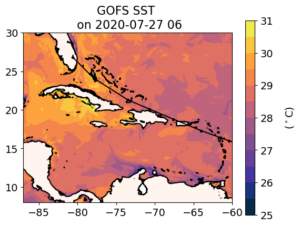

Now for the surface salinity as a proxy look at the barrier layers. Copernicus is generally fresher, possibility with more substantial barrier layers.
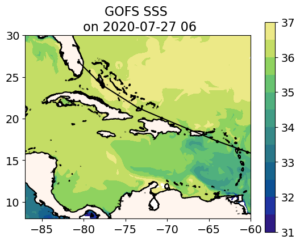
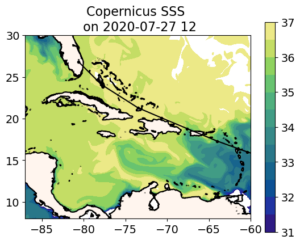
Warmer Sea Surface Temperature (SST) and lower sea surface salinity (SSS) in Copernicus mean more potential for intensification with the Copernicus ocean.



